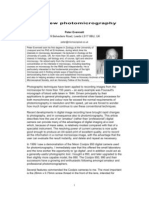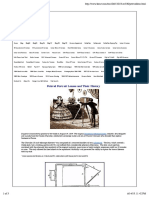A Quick Guide To Lenses
A Quick Guide To Lenses
Uploaded by
api-248669929Copyright:
Available Formats
A Quick Guide To Lenses
A Quick Guide To Lenses
Uploaded by
api-248669929Original Title
Copyright
Available Formats
Share this document
Did you find this document useful?
Is this content inappropriate?
Copyright:
Available Formats
A Quick Guide To Lenses
A Quick Guide To Lenses
Uploaded by
api-248669929Copyright:
Available Formats
A Quick Guide Lenses A Quick Guide To Lenses It is my humble opinion the lens is the single most important part
of the camera, as its function is to gather and focus the reflected light onto the sensor thereby creating the image. The lens is also one of the most easily overlooked components of the camera, especially by beginners. While a good quality lens does not guarantee good quality images, a poor quality lens almost always insures poor photographs. With this in mind lets launch into a discussion about the merits of lenses, or as the pros say glass. Focal length: All lenses are measures in focal length. The higher the number the more a lens magnifies the image and the more narrow the field of view. Wildlife and sports photographers typically use very long focal length lenses, 400mm 1200mm are not uncommon while landscape photographers favor wide angle lenses with their lower numbered focal length that are designed to take in a wider view, 16mm for example would be considered a very wide lens. Crop Factor: The focal length numbers of lenses were worked out years ago for 35mm film cameras, when these same lenses are used on a newer digital camera with a smaller image sensor than 35mm piece of film you get a bonus zoom factor. Most consumer, and even some professional grade, digital cameras are based on APS (advanced photo system) sized film sensors which are smaller than a 35mm frame of film by about one third. In order to calculate the actual focal length of a lens on a crop body camera you need to multiply the crop factor (for Canon it is 1.6x, Nikon 1.5x, Olympus 2x ) by the focal length printed on the lens. So a 100mm lens when used on a crop body Canon camera becomes a 160mm lens! Bonus! It is important to note that many newer or next-generation lenses made today are designed specifically for small sensor digital cameras HOWEVER they STILL USE THE OLD MEASURING SYSTEM, therefore even if you are using lenses designed specifically for a digital camera, such as the Olympus 4/3 system, you must multiply by your cameras crop factor to figure the exact focal length of your lens. Zoom verse Prime Lenses are divided into different categories: The first such category is prime verses zoom Prime Lenses: have a fixed focal length, you cannot zoom in and out with a twist of the zoom ring on the barrel of the lens. Prime lenses will always have a focal length expressed as a single number such as 50mm. Zoom Lenses: have a range of focal length that allows the photographer to move from one focal length to another by simply twisting a ring. Zoom lenses always have a focal length expresses in a range of numbers such as 17-85 mm indicating that the lens focal length can vary or zoom from 17-85mm. Both types have their advantages and disadvantages. Zoom lenses are very convenient, they are sometimes a bit pricey verses their prime lens counterparts. Prime lenses usually produce sharper images and almost always have wider aperture settings than their zoom lens counterparts. Why? When
Page |1
A Quick Guide Lenses designing the zoom mechanism, optical engineers must make compromises that are not required when designing prime lenses. Prime lenses can, by their nature, allow more light to enter the camera and create a more sharply focused image on the picture plane, especially in the corners of the image where lens deficiencies typically manifest themselves. For the most part, prime lenses are less expensive than their zoom counterparts of equal quality. This brings us to the subject of cost and build quality. Many lens companies divide their lenses into three distinct cost categories, these are: entry level (sometimes called kit lenses), enthusiasts level and professional grade lenses. Lens Quality Entry level or kit lenses are often included with a camera and are usually at the bottom of the lens food chain. This is not to imply that these lenses are poor quality, most are not. The actual glass elements and image quality sometimes exceed that of professional quality lenses from the 1950s and 60s. The bottom of the food chain comment is meant to indicate that in order to keep costs low, optical engineers must cut some corners. These are usually: build quality, which is often lower than the high priced lenses, the lens mount (where the lens mates to the camera) is often made of plastic verses the metal mounts found on higher priced lenses, the autofocus motor which typically uses older and slower technology than those found on higher priced lenses and sometimes the coatings used on the glass elements as well as the quality of the glass in the optics itself is lower. Can I still take excellent photos with my kit lens? Of course, however when pushed hard in difficult lighting situations kit lenses will produce some undesirable outcomes. These will be mentioned in the lens defects portion of this discussion. Enthusiasts or mid grade lenses. These lenses are designed with semi-professionals and serious amateurs in mind and priced accordingly. They usually feature more robust construction, thicker and more substantial lens barrels, distance scales on the lens, better quality optics and coatings and faster state of the art focusing motors. Sometimes these lenses are weather sealed to keep out moisture, something that can outright destroy a lens. Their cost can easily run 3 to 5 times that of a comparable kit lens. Are the results worth it? That depends of what you expect out of your camera and photographs. Bear in mind that lenses maintain their value over time and that these are investments. If well maintained, any lens can be sold or traded used for almost all of its original purchase price.
Professional grade lenses, these are the no-compromise, cream of the crop, top of the line lenses that are priced accordingly, some costing as much as a good used car. Most if not all of the issues discussed in lens defect portion of this discussion do not exist in these lenses. They are made to the highest standards, with the best, ultra low dispersion glass that can be manufactured; the aperture on these lenses is designed to be the widest of any of the three categories. Their build quality is superb as these
Page |2
A Quick Guide Lenses lenses are designed for professional use and sometimes abuse as they are sometimes dragged through the deserts or rain forests by their owners. They are always weather sealed to keep out moisture and are often cherished by their owners as lifetime investments. For our purposes a good comparison is the three variants of the Canon 50mm prime lens. All three are well respected lenses, each of which produces excellent quality images, here are the particulars: Canon 50mm Prime f1.8 Cost: around $125.00 Build Quality: poor, plastic mount, thin plastic barrel, older, noisy, slow autofocus motor Image quality: Surprisingly, very good for a $100.00 lens Canon 50mm Prime f1.4 Cost: around $380.00 Build Quality: Very good, thick plastic barrel, high speed, quiet focusing motor, distance scales and metal lens mount. Image quality: Excellent, but it can be a touch soft at 1.4-1.8, razor sharp at 2.0 Canon 50mm Prime f1.2 Cost: around $1600.00 Build Quality: Superb, metal barrel, coated with weather sealed plastics, state of the art focus motor, no compromise low dispersion optics and coatings Image quality: Unmatched, incredibly sharp, crystal clear images even at wide open apertures.
There you are, three 50mm lenses from the same manufacture clearly illustrating the differences in price and quality between the three grades of lenses, under the right conditions all three will produce memorable, excellent photographs. Image Stabilization Image stabilization is a new technology designed to reduce or eliminate the inevitable microscopic shaking of the photographers hands while the shutter is open. As you know by now any camera movement while the shutter is open, no matter how small, is recorded onto the image sensor and manifests itself as fuzzy or out of focus images. Image stabilization comes in two flavors: In Lens and In Body.
Page |3
A Quick Guide Lenses In body image stabilization works by having a series of micro gyroscopes in the camera body that detects camera movement and instantly shifts the image sensor around using a set of micro motors to cancel that movement out. Say, while I am shooting, my hand twitches and tilts the entire camera body up a millimeter or two, the gyros will sense this and in a microsecond shift the image sensor down to compensate. Its pretty incredible. In lens image stabilization does the same except that the gyro sensors are located in the lens and shift a central lens element up or down, left or right to instantly shift the image around on the stationary image sensor. Image stabilization does work to an extent. Lets assume that you are shooting a dimly lit room and hand holding your camera, with older cameras the slowest you would want to take your shutter speed would be around 1/30 of a second. Any slower and you will produce fuzzy, out of focus images. With an image stabilized lens or camera it is possible to take the shutter speed down to as low as 1/8 of a second and still get a sharp image. Benefits and cons of in body verses in lens: In body image stabilization, as found in Olympus and Pentax cameras have the benefit of making all your lenses image stabilized whereas the Canon and Nikon (called vibration reduction) versions are located in the lens meaning that the cost of the lens increases IF you purchase image stabilized lenses. I am a fan of image stabilization, especially with long telephoto lenses, whether in the camera body or lenses it has been my experience that is adds an effective, useable two to three stops of shutter speed to slower shutter shots. I have yet to arrive at a compelling reason to prefer lens based over body based image stabilization other than the decreased cost of comparable lenses without IS. It is still the position of many photographers that a better alternative to image stabilization is to simply use fast lenses (lenses with much wider maximum apertures) that allow you to keep the shutter speed higher, thereby minimizing the time the shutter is open and camera shake. I find that combining fast lenses with image stabilization is an unbeatable combination, offering todays photographers low light shooting abilities unknown to our predecessors. Different Types of Lenses Besides being divided into categories of prime and zoom, lenses are divided into various families of functionality. Lets examine these: Wide Angle: these lenses are designed to take in as wide a view as possible; they typically have a focal length of 10 28mm. These lenses are almost always zoom lenses. Fisheye: these are very wide angle specialty lenses designed to produce a spherical distortion effect, a lot like looking through a peephole in a door. Most fisheye lenses are 6 to 10mm in focal length and can be either zoom or prime. Macro Lenses: these are designed to produce excellent results at extreme close up. These lenses are always prime lenses. Most macro lenses are 50 to 100 mm in focal length. Some macro lenses can
Page |4
A Quick Guide Lenses perform double duty as excellent portrait lenses. Others like Canons MP-E 1-5 X are highly specialized and allow the photographer to fill the entire frame with the compound eye of a tiny spider! Portrait Lenses: These are almost always prime lenses that are designed to produce super sharp images and dreamy out of focus blur in the background. They are optimized to work best at a distance of 5 to 10 feet from their subject and fill the frame with an object that about the size of a size of a human head and shoulders. Normally 80 to 100mm in focal length for lenses designed for 35mm full frame digital; cameras 60 mm for lenses designed for crop body cameras (calculating the crop factor, a 60mm lens becomes an 85mm lens when used on a Canon APS camera). Telephoto lenses: These are lenses designed to enlarge an image that is a far distance from the camera. Technically lenses longer than 50mm are considered telephoto, most photographers consider a long lenses anything past 100mm a telephoto. Telephoto lenses can range from 70 to 1600mm and can be zoom or prime lenses. Tilt shift lenses: A specialty lens that allows a photographer to cancel out the effects of perspective lines by tilting and shifting the lens in relationship to the cameras film plane, useful when photographing (and cancelling out) the perspective lines associated with tall buildings. These can be either zoom or prime. An inexpensive variant of this lens is manufactured by LensBabies. Walking Around Lens: This is a slang term given to a lens that performs well under a variety of circumstances and conditions. My current walking around lens is a Canon EF-S 17-85. Ok performance wide (some barreling), very good performance medium to long. Good contrast and color reproduction. Maximum f stop 3.5, which could be a lot better, makes this a daylight only lens.
Lens defects (which manifest themselves as image defects) Vignetting aka light falloff: manifests itself as dark corners in the photograph, most common on long telephoto lenses. Chromatic Aberration (colors that arent really there): this occurs when the lens begins to act like a prism rather than focusing the light it begins to split them into red and green. These colors begin to appear as fringes of color in the white and highlight areas of the corners of the image. Barrel Distortion: happens when straight lines are distorted by the lens and become curved lines. Often apparent in wide angle lenses of lesser quality. Flare: occurs when direct light from a source enters the lens. Flare is controlled by the manufacturer applying coatings to the lenses designed to reduce the effects of direct light. Kit lenses often lack this coating and are more prone to flaring. Harsh Background Blur (aka bad bokeh) While not technically a defect, good bokeh is the term give to background blur that is pleasing to the eye, harsh bokeh is apparent when lenses that have fewer iris
Page |5
A Quick Guide Lenses blades render background blur that is harsh, unpleasant or distracting. Higher priced lenses have more iris blades that have curved ends which render more present bokeh or smoother background blur. In Response to These Issues Peripheral Illumination correction: This is an exciting new feature on some upper end digital cameras whereas the camera keeps an internal database of known defects to certain lenses and automatically compensates for them as it processes the image. Software Compensation: Raw image processing software such as DxO optics Pro, Aperture but Apple and Photoshop can be setup to remove lens defects such as chromatic aberration, barreling and vignetting.
Non-OEM lenses The autofocus system in your camera body is designed by the manufacturer to work with the lenses created by that manufacturer, they usually do not share or license those specifications to other lens manufacturers such as Sigma or Tokina. These manufacturers must backwards engineer which of those electronic contacts on the lens sends the signals to the focus motor and aperture. It has been my experience that some of these lenses are quite good and others are real stinkers in terms of image quality and autofocus performance. I will not go into detail regarding which aftermarket lens manufacturers produce lenses that create really great images and which do not. It has been my general experience that the autofocus capabilities of aftermarket, non-OEM lenses is oftentimes lagging behind the autofocus capabilities of OEM lenses from the camera manufacturer. If autofocus is not a priority then there are some really great lenses that can be mounted on Nikon, Canon and other cameras from Zeiss, Voightlander, Leica and even Rokinon, that may be worth consideration, I would carefully research any non-OEM lens I was considering purchasing (heck, I carefully research EVERY lens I consider purchasing!)
In Conclusion You have purchased a digital camera, which also means that you have also bought into a family of lenses. If you follow the logic, it usually goes something like this: I purchased a Canon EOS Rebel, while I love shooting family gatherings and the kids, I would like a nice macro lens to take better pictures of flowers or a hummingbird. So I go out and buy one. Then, a year or so later I get a hankering to do some birding or wildlife photography so I shell out for a nice telephoto zoom. Suddenly I have three lenses and an older Canon body, so when I upgrade I can save money by buying that new 20 megapixel state of
Page |6
A Quick Guide Lenses the art camera as a body only and use my perfectly good lenses! So you see, when you purchased the camera you also bought into a family of lenses. Finally, changing a lens fundamentally changes the way you use the camera, you almost have to learn to compose your shots all over again, but the fun is in exploring the possibilities a new lens offers over your old kit lens as your photos suddenly take on new dimensions. Be very careful, buying and learning how to use new lenses can be a very addictive habit!
Page |7
You might also like
- Emily DickinsonDocument278 pagesEmily DickinsonCandelaria GrisafiNo ratings yet
- The Bronica Focus ProblemDocument9 pagesThe Bronica Focus ProblemruifeijaoNo ratings yet
- CLN35 Bokeh enDocument45 pagesCLN35 Bokeh enreplik1212No ratings yet
- LEE Filters - The System BrochureDocument55 pagesLEE Filters - The System BrochureAngelo ContiniNo ratings yet
- Kilfitt Catalog-Kling Photo Corp.Document16 pagesKilfitt Catalog-Kling Photo Corp.Arnaldo0% (1)
- Gitzo Systematic LeafletDocument8 pagesGitzo Systematic LeafletOzan OzanNo ratings yet
- Chennai Peripheral Ring RoadDocument133 pagesChennai Peripheral Ring RoadVignesh100% (1)
- The New Photomicrography: Peter EvennettDocument10 pagesThe New Photomicrography: Peter EvennetttmdcorpNo ratings yet
- Phase One Lens Overview1Document12 pagesPhase One Lens Overview1mrk_webberNo ratings yet
- Alternative Exposure SystemDocument5 pagesAlternative Exposure SystemchioqueNo ratings yet
- LgFormatLenses PDFDocument16 pagesLgFormatLenses PDFjaviercj5477No ratings yet
- SIGMA LENS CatalogueDocument15 pagesSIGMA LENS CatalogueDeeNo ratings yet
- Plaubel Makina 67 ReviewDocument5 pagesPlaubel Makina 67 ReviewkamonexNo ratings yet
- The LEE System BrochureDocument33 pagesThe LEE System BrochureIvo Vitanov VelinovNo ratings yet
- Yoshihisa Maitani - The Olympus OM-1 - The XA SeriesDocument19 pagesYoshihisa Maitani - The Olympus OM-1 - The XA SeriesDentobiasNo ratings yet
- Bolex h16 ReflexDocument52 pagesBolex h16 ReflexJuan Diego QuinteroNo ratings yet
- Light Seal Replacement - Matt's Classic CamerasDocument6 pagesLight Seal Replacement - Matt's Classic CamerasAntonio CompanyNo ratings yet
- Basic 35mm DofDocument5 pagesBasic 35mm DofMario YeeNo ratings yet
- Black and White Film PhotographyDocument11 pagesBlack and White Film Photography1469No ratings yet
- Ultrawide LensDocument80 pagesUltrawide LensJoe Green100% (1)
- Large Format Lenses From Eastern Bloc 1945-1991Document33 pagesLarge Format Lenses From Eastern Bloc 1945-1991MalaNo ratings yet
- Astronauts Manual Singlepage LRDocument40 pagesAstronauts Manual Singlepage LRMichael ZhangNo ratings yet
- US Army Photography Course SS0522-0 - Operation and Maintenance of Photographic EquipmentDocument296 pagesUS Army Photography Course SS0522-0 - Operation and Maintenance of Photographic EquipmentGeorgesNo ratings yet
- Power To Your Next Step: We All Have A Next Step. Capture The Moment at Seven Frames Per SecondDocument11 pagesPower To Your Next Step: We All Have A Next Step. Capture The Moment at Seven Frames Per Secondspscribd1No ratings yet
- 20 Years of Canon EOSDocument11 pages20 Years of Canon EOSrobertcheNo ratings yet
- Flexaret IDocument25 pagesFlexaret IRRay ChroeNo ratings yet
- Leica M6 Horizontal Rangefinder AdjustmentDocument7 pagesLeica M6 Horizontal Rangefinder AdjustmentMalaNo ratings yet
- Instruction Manual Mount Change Instructions Zeiss Cinema Zoom LensesDocument24 pagesInstruction Manual Mount Change Instructions Zeiss Cinema Zoom LensesdimodimoNo ratings yet
- En CLB41 Nasse LensNames DistagonDocument15 pagesEn CLB41 Nasse LensNames DistagonseifadiazNo ratings yet
- Canon Canovision 8 Manual English Ma 2439Document17 pagesCanon Canovision 8 Manual English Ma 2439Ian88No ratings yet
- Arriflex 16BLDocument24 pagesArriflex 16BLcvaldesloraNo ratings yet
- Types of CameraDocument16 pagesTypes of CameraOsman Gumanti Ahmad AlbabNo ratings yet
- Lomolovers Vol7Document65 pagesLomolovers Vol7lerdevagarNo ratings yet
- 3D Photography - Frequently Asked QuestionsDocument52 pages3D Photography - Frequently Asked Questionswilsonjoe100% (1)
- Nikon D3s BrochureDocument8 pagesNikon D3s BrochureJose GutierrezNo ratings yet
- En Tamron LensDocument15 pagesEn Tamron Lensyehtut23No ratings yet
- The History of Petzval Lenses PDFDocument3 pagesThe History of Petzval Lenses PDFAlek StankovicNo ratings yet
- Purchasing A New LensDocument22 pagesPurchasing A New LensrocarlovichNo ratings yet
- Re-Cementing Lens Elements With Canadian Balsam.Document6 pagesRe-Cementing Lens Elements With Canadian Balsam.MalaNo ratings yet
- Large Format Lenses From VEB Carl Zeiss Jena 1945 - 1991Document28 pagesLarge Format Lenses From VEB Carl Zeiss Jena 1945 - 1991Petter willNo ratings yet
- Shutter Speed and ApertureDocument46 pagesShutter Speed and ApertureFweeda MkNo ratings yet
- Carl Zeiss Planar T 45mm f/2 LensDocument2 pagesCarl Zeiss Planar T 45mm f/2 LensNikonRumorsNo ratings yet
- Sinar P-SLR ENDocument4 pagesSinar P-SLR ENsunobNo ratings yet
- Honeywell Pentax: To Print, Try Printing Only 3 or 4 Pages at A TimeDocument16 pagesHoneywell Pentax: To Print, Try Printing Only 3 or 4 Pages at A Timeben_65No ratings yet
- Bronica Gs 1 Medium Format CameraDocument30 pagesBronica Gs 1 Medium Format Camerachandra-calgaryNo ratings yet
- Tether Tools Insight Inspiration Volume 5Document10 pagesTether Tools Insight Inspiration Volume 5Paul DragomanNo ratings yet
- S2A ManualDocument41 pagesS2A ManualvepsalainenNo ratings yet
- Koni-Omega Rapid PDFDocument25 pagesKoni-Omega Rapid PDFHabibiy StauffanbergNo ratings yet
- Basic Manual Control of A SLR Camera: Photographers Don't Just Take Photographs - They Make Them !Document16 pagesBasic Manual Control of A SLR Camera: Photographers Don't Just Take Photographs - They Make Them !Sairam EdupugantiNo ratings yet
- Camera DesignDocument12 pagesCamera DesignSahil TiwariNo ratings yet
- History: Camera Lenses Focal Length Viewfinder MirrorDocument8 pagesHistory: Camera Lenses Focal Length Viewfinder MirrorLemuel BacliNo ratings yet
- The SIGMA SD15. The World's Only Integral, Three-Layer, Complete-Color Sensor. The Camera That Captures It AllDocument24 pagesThe SIGMA SD15. The World's Only Integral, Three-Layer, Complete-Color Sensor. The Camera That Captures It AlloffwegoNo ratings yet
- Sigma Lens en 2014Document32 pagesSigma Lens en 2014spscribd1No ratings yet
- The New High-Performance, Fast-Aperture Ultra-Wideangle and Standard Zoom NIKKOR LensesDocument2 pagesThe New High-Performance, Fast-Aperture Ultra-Wideangle and Standard Zoom NIKKOR LensesBrilie Karl VirayNo ratings yet
- EOS - 7D Brochure V 2Document16 pagesEOS - 7D Brochure V 2dkahunaNo ratings yet
- Lee Filters - System-OverviewDocument8 pagesLee Filters - System-OverviewAlejandro ContrerasNo ratings yet
- Kyle K’S Night & Light Photography: Photography at the Next LevelFrom EverandKyle K’S Night & Light Photography: Photography at the Next LevelNo ratings yet
- B (I-1A) Fundamentals of Reservoir Phase BehaviorDocument92 pagesB (I-1A) Fundamentals of Reservoir Phase BehaviorAndrei Horhoianu100% (1)
- Journal of Business Research 101 (2019) 697-706Document21 pagesJournal of Business Research 101 (2019) 697-706Atika FithrianiNo ratings yet
- Assessment-1: Environment Protection Act, 1986 Which Contains Various Provisions On EIADocument13 pagesAssessment-1: Environment Protection Act, 1986 Which Contains Various Provisions On EIAJas Sahib ChadhaNo ratings yet
- Ashtakavarga System of Prediction BV Raman PDF DownloadDocument2 pagesAshtakavarga System of Prediction BV Raman PDF DownloadvishalNo ratings yet
- Catalog MercuryDocument4 pagesCatalog Mercuryapi-3749499No ratings yet
- Boom and Bucket HidraulicsDocument44 pagesBoom and Bucket HidraulicsSERGIO CARDENAS CASTILLONo ratings yet
- Application of HPI (Heavy Metal Pollution Index) and Correlation Coefficient For The Assessment of Ground Water Quality Near Ash Ponds of Thermal Power PlantsDocument11 pagesApplication of HPI (Heavy Metal Pollution Index) and Correlation Coefficient For The Assessment of Ground Water Quality Near Ash Ponds of Thermal Power Plantssanusi bello bakuraNo ratings yet
- SV Weekly Report Small Section Sat-Sat 07-04-2024 (Recovered) FinalDocument43 pagesSV Weekly Report Small Section Sat-Sat 07-04-2024 (Recovered) FinalBadiea MudhshNo ratings yet
- MATH 8-Budget-of-WorkDocument67 pagesMATH 8-Budget-of-WorkMaricel ManlupigNo ratings yet
- Ganga Action PlanDocument33 pagesGanga Action PlanISHITA GROVERNo ratings yet
- Physical Design For Asic - NLDM VS CCSDocument1 pagePhysical Design For Asic - NLDM VS CCSRA NDYNo ratings yet
- 2.3.3 - BA Roof CoveringsDocument16 pages2.3.3 - BA Roof CoveringsTom UsupuNo ratings yet
- Lecture1 Set Theory p1Document24 pagesLecture1 Set Theory p1Angelo Paolo CamotaNo ratings yet
- Chapter 1-3Document53 pagesChapter 1-3Joven Loyd IngenieroNo ratings yet
- Factors Affecting The Performance of Shell and Tube Heat ExchangerDocument9 pagesFactors Affecting The Performance of Shell and Tube Heat ExchangerMuhammed NayeemNo ratings yet
- BS EN ISO 3059 2001, Nondestructive PDFDocument11 pagesBS EN ISO 3059 2001, Nondestructive PDFmerim1984100% (2)
- Arndt Et Al - 2005Document8 pagesArndt Et Al - 2005Felipe MatheusNo ratings yet
- NGT Feeding: by Group 2Document25 pagesNGT Feeding: by Group 2karl montano100% (1)
- Solidification NucleationDocument29 pagesSolidification NucleationYehia RaefNo ratings yet
- CHAPTER IV (Cidro)Document84 pagesCHAPTER IV (Cidro)Czindy MoradosNo ratings yet
- Resume For Student PilotDocument7 pagesResume For Student Pilotgt72k5e5100% (1)
- FPGA Based Implementation of Symmetrical Switching in SVPWM For Three Level NPC ConverterDocument6 pagesFPGA Based Implementation of Symmetrical Switching in SVPWM For Three Level NPC ConvertersateeshNo ratings yet
- Battery Tutorial: SLI BatteriesDocument4 pagesBattery Tutorial: SLI BatteriesAbdullah Al AsikNo ratings yet
- PMS 1Document3 pagesPMS 1Manuel CoronelNo ratings yet
- ANSWER KEY OF SOUND WAVES Online TestDocument17 pagesANSWER KEY OF SOUND WAVES Online TestKhanNo ratings yet
- The Philosophy and Symbolism of FreemasonryDocument10 pagesThe Philosophy and Symbolism of FreemasonryAngelyn Zednanreh Betiola100% (1)
- Maxshield Hdpe SFDocument3 pagesMaxshield Hdpe SFSean HarshaNo ratings yet
- AML Installation and Maintenance ManualDocument143 pagesAML Installation and Maintenance Manualharis100% (1)

























































































